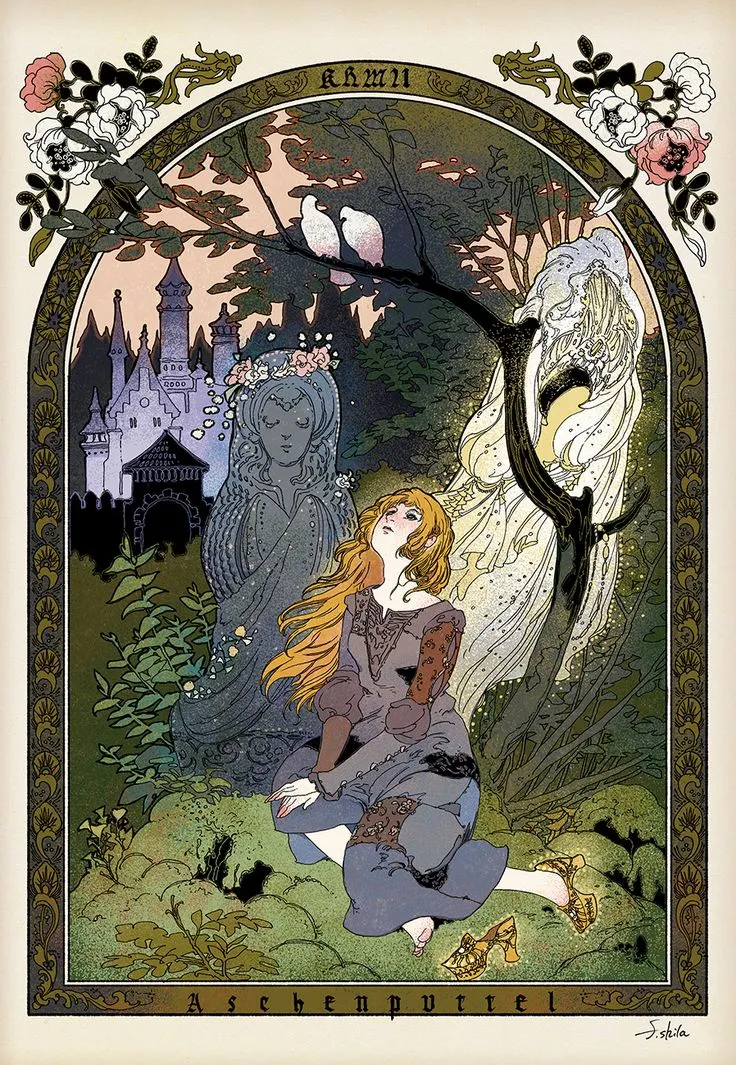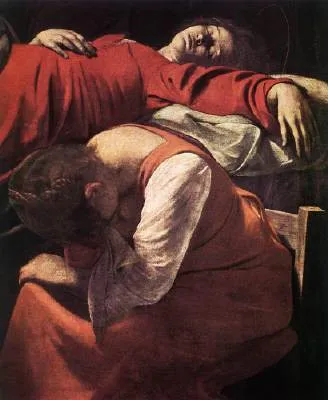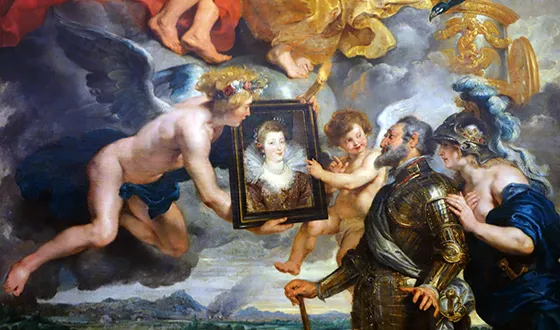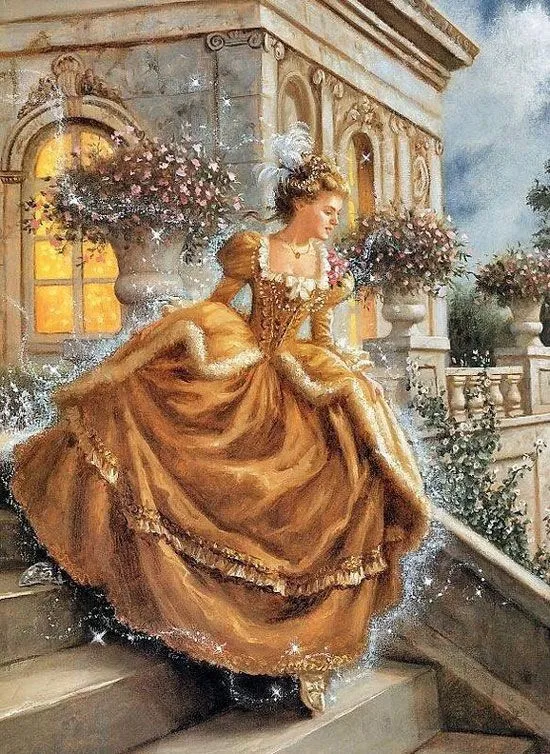
Before We Get Started
This was an enjoyable bit of research and thought; Thumbs up to @mikisolus who requested Cinderella in the comments of Fables & Meaning Part 2.
Now to get started: My interpretation of Cinderella comes from three versions of this story. The idea of the slipper goes very far back into history, so I decided to start with the first recognizable emergence of Cinderella. This was written by Basile in 1634. Later in 1697 a version was written by Perrault. Finally , in 1812 a version was written by Grimm.
If you are unfamiliar with the fable Cinderella each of the above Author names links to the page containing their version of the story.

Zezolla's maternal mother died and on her deathbed she gave the gift of a universal truth to Zezolla, "Dear child, remain pious and good, and then our dear God will always protect you, and I will look down on you from heaven and be near you,"(Grimm). For Zezolla this became the foundation of her very being; Many of us can only imagine the impact on our soul of hearing such a statement from our dying mother, especially if we are only a child. Zezolla's life was forever changed.
Even in the face of unimaginable cruelty Zezolla does not waver from her maternal mother's dying words.

In Fables like life we create our own troubles. Sometimes through our evil or indifference and in those cases deservedly we might say. Yet more often than not, we seem to create our troubles in the most injustice of ways and that is through our kindness and willingness to see the best of those around us.
Zezolla unfortunately is the latter of the two and through her need for a mother, thought she found one in her governess. Sadly people are not always what they seem; There are many examples of this warning, "beauty in the eye of the beholder", "It's not what's on the outside, but what's on the inside". All warnings that you need to take a moment and stop imaging who a person is and actually listen to them and figure out who they are.

Once the Governess became the Step-Mother she took a physical and mental hold of the father. Zezolla was thus quickly shuffled to the status of wench, while her Step-Sisters took the places of Princess. Zezolla was made to clean, cook, "sleep by the hearth in the ashes", (Grimm) and do all sorts of menial tasks.
Side Note: Now we have the emergence of the name "Cinderella" which was one of the nicknames given to Zezolla due to her ash covered appearance. Cinder or Cinderella

Of these menial tasks, one in particular has a symbolical meaning. The picking up of lentils out of the ashes. This punishment is similar to that of Sisyphus, who was required to endlessly push boulders up a hill. The Step-Mother continues to give Cinderella this task implying Cinderella is crafty and deceitful in her eyes, otherwise she could not complete such a task.

The introduction of heavenly bird's into the story was not completely original to Jacob and Wilhelm Grimm's version, but they used these symbols so beautifully that I would have to give them the credit. As a side note, it's also why I enjoy their version the most. Their ability to write a 500 page novel in less than 200 words is a unique gift and wonderful to read.
The White Bird or White Dove is the embodiment of Cinderella's mother. Remember the Dying Mother's statement, "Dear child, remain pious and good, and then our dear God will always protect you, and I will look down on you from heaven and be near you", (Grimm). When Cinderella's father asked her the gift she wanted, all she wanted was a twig. "Father, break off for me the first twig that brushes against your hat on your way home," (Grimm). She wanted this twig to plant at her mother's grave, then she weep while knelt before the twig giving it the water from her tears to become a tree. This is the act of both goodness and piousness that brought forth Cinderella's mother and the protection of God. The twig collected by chance also brought power to Cinderella. The twig was of a Hazel tree, a symbol of White Magic, Wisdom and Healing.

All Cinderella had was be good and pious. She was never told that she is good and pious, or shown the slightest affection after the arrival of the stepmother and stepsisters. Cinderella's lack of external worth was a symbolic reflection of her lack of internal worth. She returns home the first night of the feast and does not realize how popular she was until her stepsisters talk about the beautiful princess that was at the ball. On the second night Cinderella inquires to her stepsisters about the woman and again is given another self-esteem boost. Yet even that is not enough, she still runs away the third night. Thankfully the Prince took precautions and put pitch on the steps causing Cinderella to lose a slipper.
(off topic - @dtworker I think you posted a meme about "if the slipper fit why did she lose it" well there you go, it was pitch, still a good meme though, keep it up)
This is important though, because we all have met someone that was utterly destroyed mentally by their family. That kind of suffering doesn't go away over 3 days like in the fairy-tales. You should think about this, when you were a kid did you encourage that boy or girl or did you help to further their destruction? Might be too late for you to go back and right your wrongs, but it certainly isn't to late to teach your children how to be good and pious.
Having a desire or goal is good, but don't let those desires or goals take you out of reality. May not result in a terrible stepmother, but watch out, because if you start making decisions based on the "what it could be" and ignoring the "what it is" you're going to end up in one terrible place.
We aren't as Good and Pious as Cinderella, but you know what, that's OK. The important thing is realizing you could be better or you could work harder or you could be a bit more empathetic to others. No body is Good, but we can work on doing more Good things than Bad things.
One final piece to revisit here, I didn't address the punishment the stepsisters received in Grimm's version of the story or the foot mutilation. The first stepsister cutting off her toe to fit into the slipper and then the second stepsister cutting off a chunk of her heal to fit into the slipper. These actions go hand in hand with being evil and are there to symbolize the evil offerings of flesh for happiness. Though of course the Pigeons, which are messengers, tell the prince of the stepsisters deceit. The punishment resulting in the blinding of the stepsisters, I believe this is a statement something like. "All you see you selfishly covet for yourself, then be blinded from your coveting desires so you may look inward and possibly be healed".
Just Click the Link Below to Read: Fables & Meaning Part 2: Hansel and Gretel

Fables And Meaning Part 2: Hansels and Gretel
Just Click the Link Below to Read: Fables & Meaning Part 1: Three Wishes

Fables And Meaning Part 1: Three Wishes
References:
http://courses.wcupa.edu/johnson/cenerentola.htm - (Basile)
http://www.pitt.edu/~dash/perrault06.html - (Perrault)
http://www.pitt.edu/~dash/grimm021.html (Grimm)